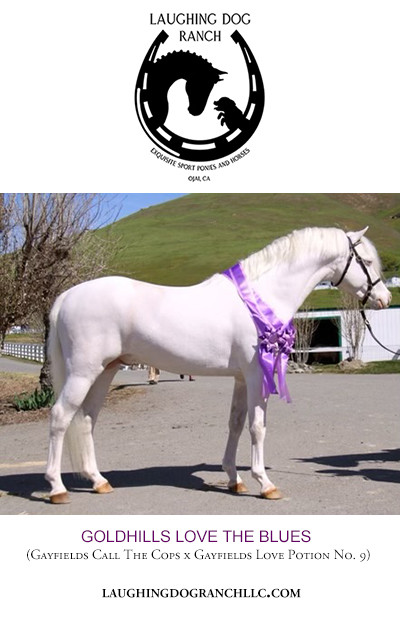No Time to Call A Veterinarian With This Emergency - The Peril of Red Bag
By Cindy Reich
Foaling time is here and as Charles Dickens said, “It was the best of times, it was the worst of times…” The vast majority of the time, it really is the best of times. All the dreams and expectations — all the time, energy, expense and hope that goes into getting a mare pregnant, are telescoped to 20 minutes when the foal is born.
Horses have one of the most explosive births of large animals. From the time the water breaks until the foal is out of the mare is about 20 minutes. Most of the time, it all goes well. When things go wrong, however, they go wrong in a hurry and there is not much time to fix it.
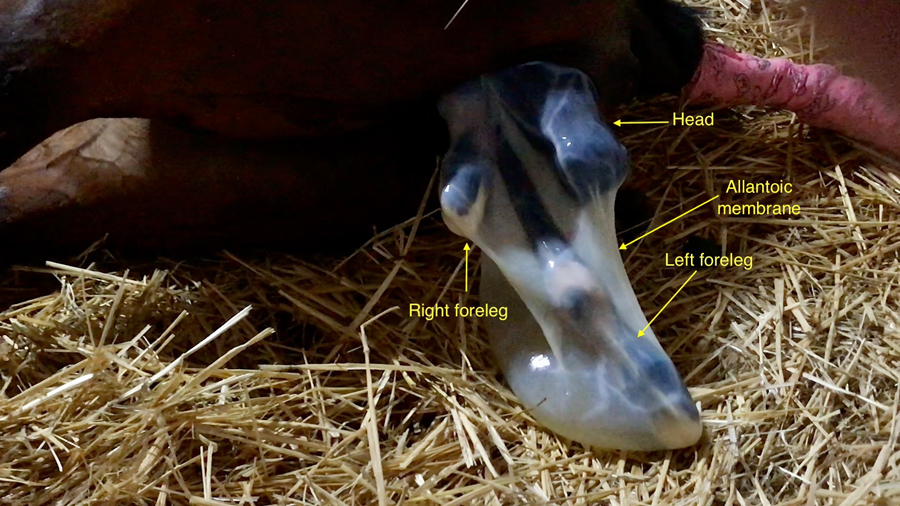 Normal presentation.
Normal presentation.
Foaling in the mare is comprised of three stages. Stage One is that period of time just prior to foaling, when the foal changes position from being on its back, to turning around so that the front feet are extended forward towards the mare’s cervix and the foal’s nose is resting just below its knees. This is the normal position for foaling. When the mare’s water breaks, that is the end of Stage One and the beginning of Stage Two labor.
If you are attending the foaling and this situation occurs, you must take charge of the situation yourself, or you will lose the foal.
As the mare’s contractions push the foal through the birth canal, a bluish-white translucent bag (the allantoic membrane) containing the foal appears. The forelegs of the foal become visible as well as the muzzle. In a normal foaling, it takes around 20 minutes for the foal to be born. Once the foal has been expelled, it is the end of Stage Two labor.
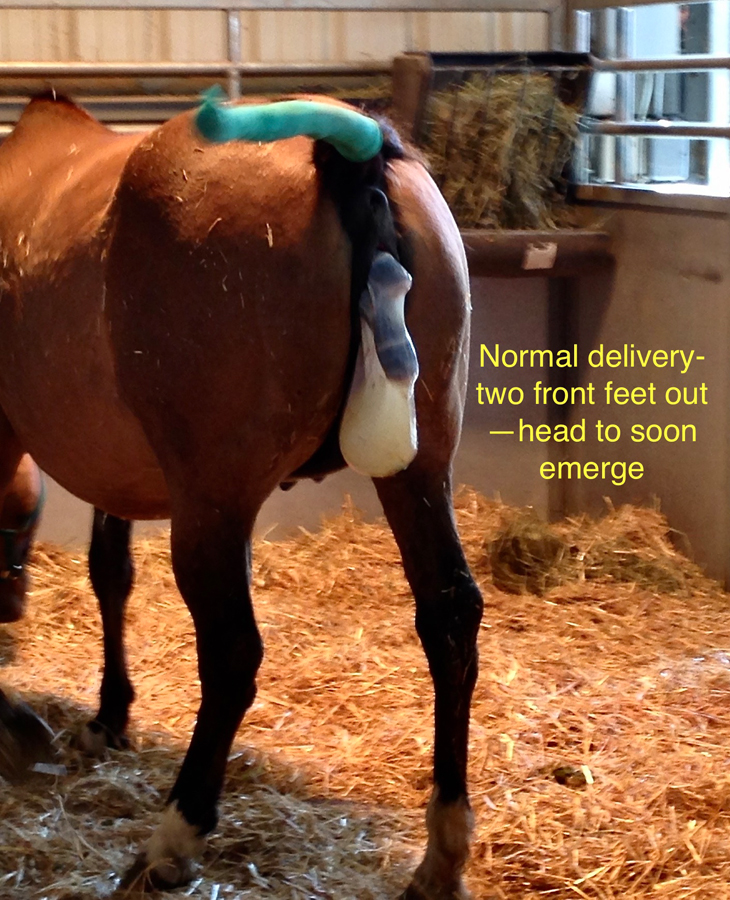 Normal delivery.
Normal delivery.
Anything other than the foaling position described above is considered a mal-presentation or dystocia. When this occurs, intervention is often required to deliver the foal safely. Mild dystocia such as an elbow lock, or a hip lock can usually be resolved by trained staff at the farm. But if it is a more serious dystocia, a veterinarian will be required. Giving your veterinarian a head’s up in advance of when you think the mare is going to foal is always a good idea. The veterinarian’s phone number should be in the phones of all staff members, and the phone number should be posted prominently in the barn in the event of a foaling when normal staff are not present. If your veterinarian is a long way away from your foaling mare, have a discussion well before foaling about what to do if things do not go normally. You do not want to be searching for a veterinarian during the foaling process.
So, while most foalings are “the best of times,” there is ONE situation where you do not have time to call the vet. If you are attending the foaling and this situation occurs, you must take charge of the situation yourself, or you will lose the foal.
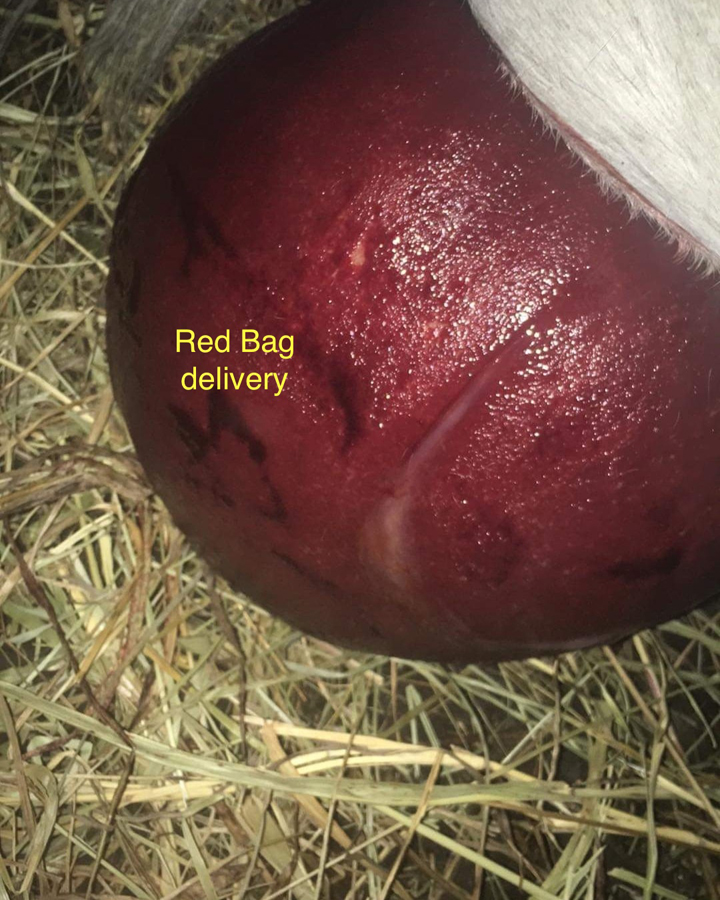 Red Bag Delivery.
Red Bag Delivery.
This situation is called Red Bag and occurs when the placenta separates with the foal when it is being born. The reason that this is an emergency is that once the placenta has separated with the foal, the foal no longer has an oxygen source. During a normal birth, the foal is receiving oxygen through the umbilical cord. Even when the neck and head are out of the mare, the foal is still getting oxygen. It will not breathe on its own until after the rib cage has cleared the mare. However, in a red bag delivery you are working against the clock, because that oxygen is no longer available to the foal.
A red bag delivery is very obvious, as a deep red/magenta bag emerges from the mare. At this point, time is of the essence. The placenta must be opened, and the foal delivered as soon as possible. It is for this reason that I always have a pair of scissors on every foaling stall or stall with a mare close to foaling. You do NOT have time to run around looking for a knife or scissors. Or if you do have to run around looking for these items, you can lose the foal.
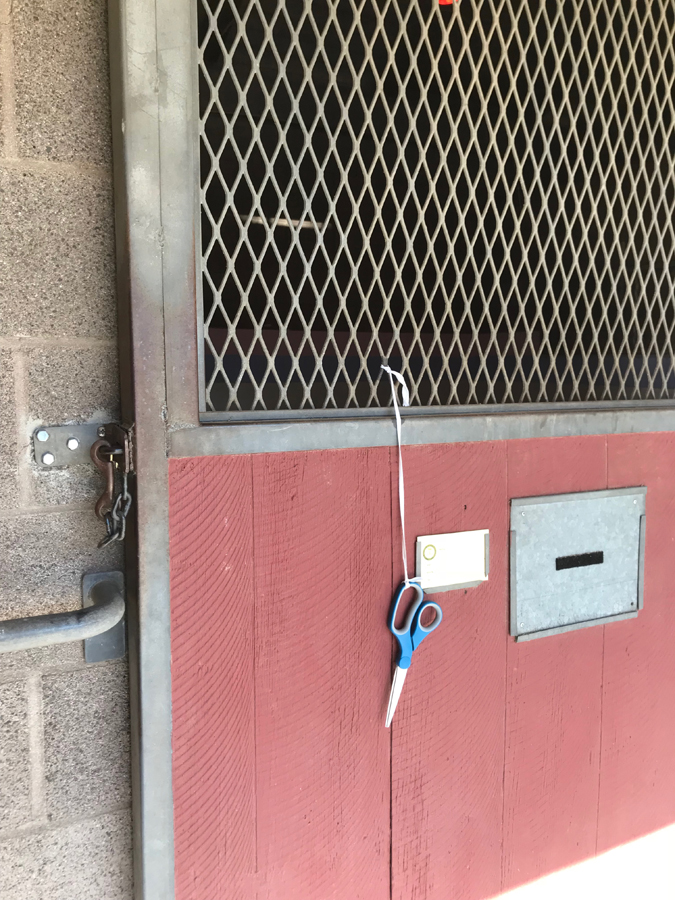 In a red bag presentation, you don’t have time to go look for a pair of scissors or a knife.
In a red bag presentation, you don’t have time to go look for a pair of scissors or a knife.
Once you see the “red bag” the scissors should be used to make a tear in the placenta so that you can grab the foal’s legs and pull it from the mare. Do not stab the scissors or knife into the bag but make a tear in the membrane and get your hands in there to feel for the anatomy. Grab the front legs above the fetlocks and pull the foal. Depending on how long it takes to get the foal out, it might be useful to use a foal resuscitator or oxygen if you have them in your foaling kit or on hand. If the foal is delivered quickly, it should be fine. But there is nothing more devastating than coming into a stall and finding a red bag delivery with a dead foal inside because there was no one attending or available to get the foal out.
While the chance of a red bag delivery is low – a 2012 study of 1,700 mares estimated a rate of 1.6 per cent – making preparations in advance of the foaling season will ensure that it really will be “The best of times.”







